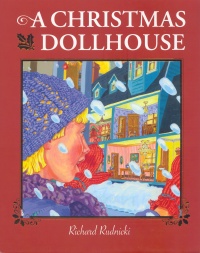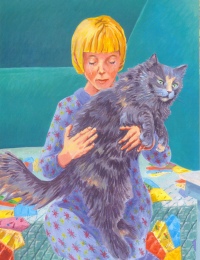| ________________
CM . . . . Volume XVIII Number 34 . . . . May 4, 2012
excerpt:
It's 1930. It's Christmas, and it seems to Dot that anything that could be wrong is going wrong. Her mother is seriously ill, and, because there's no money, her father will have to go into the forest to cut wood to earn some, and Dot and her older brother Wallis must fill in for all the chores that need to be done. And Dot has a hole in her boot.
Richard Rudnicki is establishing a reputation as an illustrator of finely detailed picture books. Gracie the Public Gardens Duck is practically a guidebook of things to see in the Halifax Public Gardens. His illustrations for Viola Desmond Won't Be Budged illuminate the spare text with feelings, atmosphere, and period details. The colours are carefully chosen to convey the mood of each part of the story. A Christmas Dollhouse is the first book that he has written as well as illustrated. For his first experience as an author, Rudnicki has chosen to retell a true story. Through a meeting with Don MacKenzie, the Wallis of the story, Rudnicki learned of this touching example of community kindness. His approach to the text is a straightforward telling, laying out the events in clear chronological order. Each brief reference in the text on one page - to the dollhouse, to the draw - is smoothly amplified on the following page. Once again, Rudnicki has provided carefully drawn illustrations that amplify the text. When editors suggested changes and deletions to his original text, these deleted characters (hoboes a typical denizen of small towns during the Depression) reappeared in the illustrations. The sunny palette of the illustrations contrasts nicely with Dot's sadness, but the story concludes with a happy ending that finally brings a radiant smile to Dot's face. There is one little flaw in the text: on the first page, where Dot is pictured inside the schoolhouse with her finger sticking out of the hole in her boot, the text reads "It was the last day of school before the Christmas holidays and Dot didn't want to go home. Outside the schoolhouse she looked up at the falling snow. One of her boots had a hole in it. She stuffed it with a bit of paper to keep the cold out." "Outside the schoolhouse" is confusing when she is clearly still inside the schoolhouse. Perhaps that sentence could be replaced with "Outside the schoolhouse the snow was falling." Or "Dot looked out at the falling snow." This is a very minor flaw for the first-time author. Though the story was not seasonal when I received the book for review, I read it to grade 4 and 5 students. The students appreciated the story and the illustrations. They stopped the reading to make connections to and predictions about the text. As Rudnicki is local, one student was able to relate that he knew several of the children who had modelled for Mr. Rudnicki as he painted the illustrations. I would highly recommend A Christmas Dollhouse for students in grades 2-5. The text is smooth and fluent, and the illustrations are beautiful and evocative of the period. The story gives a wonderful sense of a tightly knit and generous small community, a place we might all wish to live. Highly Recommended. Rebecca King is a Library Support Specialist (Elementary and Junior High) with the Halifax Regional School Board in Nova Scotia.
To comment
on this title or this review, send mail to cm@umanitoba.ca.
Copyright © the Manitoba Library Association. Reproduction for personal
use is permitted only if this copyright notice is maintained. Any
other reproduction is prohibited without permission.
NEXT REVIEW |
TABLE OF CONTENTS FOR THIS ISSUE
- May 4, 2012.
AUTHORS |
TITLES |
MEDIA REVIEWS |
PROFILES |
BACK ISSUES |
SEARCH |
CMARCHIVE |
HOME |

 On the last day of school before Christmas, Dot's kind teacher suggests that she go with her to view the dollhouse on display at the local drugstore. Mr. Russell announces that anyone who spends a dollar in his store will get a ballot for the draw to win the dollhouse. Dot falls in love with the dollhouse - it represents the perfection that her life lacks at this time - but she has no money. Later, her father sends Wallis and Dot to the drugstore with a dollar for her mother's medicine. This could be Dot's chance, but the medicine, perhaps charitably, only costs 50 cents.
On the last day of school before Christmas, Dot's kind teacher suggests that she go with her to view the dollhouse on display at the local drugstore. Mr. Russell announces that anyone who spends a dollar in his store will get a ballot for the draw to win the dollhouse. Dot falls in love with the dollhouse - it represents the perfection that her life lacks at this time - but she has no money. Later, her father sends Wallis and Dot to the drugstore with a dollar for her mother's medicine. This could be Dot's chance, but the medicine, perhaps charitably, only costs 50 cents.